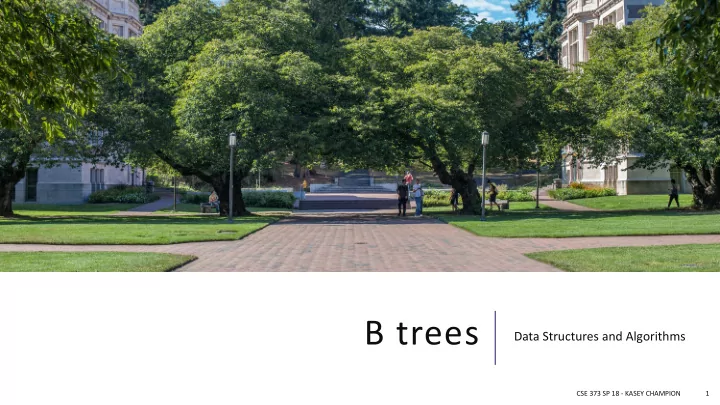

B trees Data Structures and Algorithms CSE 373 SP 18 - KASEY CHAMPION 1
Warm Up Suppose we have an AVL tree of height 50. What is the best case scenario for number of disk accesses? What is the worst case? CSE 373 SP 18 - KASEY CHAMPION 2
Memory Architecture What is it? Typical Size Time The brain of the computer! 32 bits ≈free CPU Register Extra memory to make 128KB 0.5 ns L1 Cache accessing it faster Extra memory to make 2MB 7 ns L2 Cache accessing it faster Working memory, what 8GB 100 ns RAM your programs need Large, longtime storage 1 TB 8,000,000 ns Disk CSE 373 SP 18 - KASEY CHAMPION 3
Locality How does the OS minimize disk accesses? Spatial Locality Computers try to partition memory you are likely to use close by - Arrays - Fields Temporal Locality Computers assume the memory you have just accessed you will likely access again in the near future CSE 373 SP 18 - KASEY CHAMPION 4
Thought Experiment Suppose we have an AVL tree of height 50. What is the best case scenario for number of disk accesses? What is the worst case? RAM Disk CSE 373 SP 18 - KASEY CHAMPION 5
Maximizing Disk Access Effort Instead of each node having 2 children, let it have M children. - Each node contains a sorted array of children Pick a size M so that fills an entire page of disk data log m (n) Assuming the M-ary search tree is balanced, what is its height? What is the worst case runtime of get() for this tree? log 2 (m) to pick a child log m (n) * log 2 (m) to find node CSE 373 SP 18 - KASEY CHAMPION 6
Maximizing Disk Access Effort If each child is at a different location in disk memory – expensive! What if we construct a tree that stores keys together in branch nodes, all the values in leaf nodes K K K K K <- internal nodes K V K V K V K V K V K V K V K V K V K V K V K V leaf nodes -> K V K V K V K V K V K V K V K V K V K V K V K V CSE 373 SP 18 - KASEY CHAMPION 7
B Trees Has 3 invariants that define it 1. B-trees must have two different types of nodes: internal nodes and leaf nodes 2. B-trees must have an organized set of keys and pointers at each internal node 3. B-trees must start with a leaf node, then as more nodes are added they must stay at least half full CSE 373 SP 18 - KASEY CHAMPION 8
Node Invariant Internal nodes contain M pointers to children and M-1 sorted keys K K K K K M = 6 A leaf node contains L key-value pairs, sorted by key L = 3 K V K V K V K V CSE 373 SP 18 - KASEY CHAMPION 9
Order Invariant For any given key k, all subtrees to the left may only contain keys x that satisfy x < k. All subtrees to the right may only contain keys x that satisfy k >= x 3 7 12 21 X < 3 7 <= X < 12 12 <= X < 21 21 <= x 3 <= X < 7 CSE 373 SP 18 - KASEY CHAMPION 10
Structure Invariant If n <= L, the root node is a leaf When n > L the root node must be an internal node containing 2 to M children K V All other internal nodes must have M/2 to M children K V All leaf nodes must have L/2 to L children K V All nodes must be at least half-full The root is the K V only exception, which can have as few as 2 children - Helps maintain balance - Requiring more than 2 children prevents degenerate Linked List trees CSE 373 SP 18 - KASEY CHAMPION 11
B-Trees Has 3 invariants that define it 1. B-trees must have two different types of nodes: internal nodes and leaf nodes - An internal node contains M pointers to children and M – 1 sorted keys. - M must be greater than 2 - Leaf Node contains L key-value pairs, sorted by key. 2. B-trees order invariant - For any given key k, all subtrees to the left may only contain keys that satisfy x < k - All subtrees to the right may only contain keys x that satisfy k >= x 3. B-trees structure invariant - If n<= L, the root is a leaf - If n >= L, root node must be an internal node containing 2 to M children - All nodes must be at least half-full CSE 373 SP 18 - KASEY CHAMPION 12
get() in B Trees 12 44 get(6) get(39) 50 6 20 27 34 1 1 6 4 12 8 20 12 27 15 34 18 2 2 8 5 14 9 22 13 28 16 38 19 3 3 9 6 16 10 24 14 32 17 39 20 10 7 17 11 41 21 Worst case run time = log m (n)log 2 (m) Disk accesses = log m (n) = height of tree CSE 373 SP 18 - KASEY CHAMPION 13
put() in B Trees Suppose we have an empty B-tree where M = 3 and L = 3. Try inserting 3, 18, 14, 30, 32, 36 3 1 3 1 2 18 3 14 18 32 14 3 18 2 3 1 18 2 32 5 3 4 14 30 6 36 5 32 CSE 373 SP 18 - KASEY CHAMPION 14
Recommend
More recommend